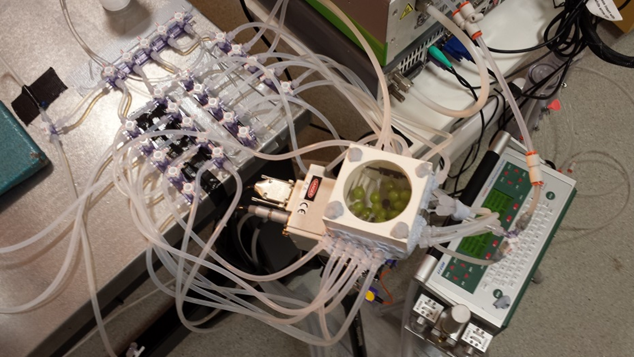Water Pools in Grape Berries RN Robertson Travelling Fellowship 2013 report
by Johannes Scharwies PhD Candidate
School of Agriculture Food and Wine, The University of Adelaide
e-mail: johannes.scharwies@adelaide.edu.au
A joint project between:
University of Adelaide, Waite Research Institute (Johannes Scharwies, Prof. Steve Tyerman)
University of Sydney, Centre for Carbon Water and Food (Dr. Kevin Simonin, Dr. Xin Song, A/Prof. Margaret Barbour)
Funding through the RN Robertson Travelling Fellowship by the Australian Society of Plant Scientists allowed me to visit the laboratory of Assoc. Prof Margaret Barbour at The University of Sydney’s Camden Campus and work with Dr. Kevin Simonin and Dr. Xin Song to investigate water pools in grape berries using novel stable isotope techniques.
As part of my previous Masters by Research and my current PhD at The University of Adelaide some of my research focuses on how different water pools in plants are integrated in the transpiration stream. During my Masters by Research, I investigated pre-harvest berry dehydration in Australia’s most popular red grape variety Shiraz, which can lead to significant yield losses. Berries that are affected show an imbalance between water uptake and water loss at the end of ripening causing shrivelling of the berries and concentration of sugars. This may make these berries less suitable for wine production.
When I presented my research at COMBIO 2012 in Adelaide, I was introduced to Assoc. Prof. Margaret Barbour and Dr. Kevin Simonin form The University of Sydney, who presented a poster on a novel stable isotope technique that they used to investigate changes in stable isotope composition of water in the leaf during transpiration. We discussed that this technique could also be used to investigate the contribution of different water pools to the transpiration stream in grape berries. This could reveal the sources of water which are lost during pre-harvest berry dehydration.
At the beginning of 2013, I was fortunate to win a scholarship to visit the workshop “Stable Isotopes in Biosphere Systems” at The University of Sydney’s Camden Campus. This workshop gave me a great overview about this topic that was completely novel to me and experiments that were part of the workshop demonstrated many different techniques that can be used to investigate the environment and plants using stable isotope techniques.
Encouraged by this workshop, I applied for the RN Robertson Travelling Fellowship to return to The University of Sydney and work on a project with the aim to use stable isotopes of water to trace water movement through developing grape berries. My successful application for this fellowship gave me the opportunity to return to Sydney at the beginning of this year.
For our experiments we used source water slightly enriched in H218O to allow calculations of berry water turnover time. Up to 20 individual berries attached to tubing for source water uptake were enclosed in a gas exchange cuvette, which proved to be better than using intact grape clusters (Fig. 1). Source water uptake was measured gravimetrically, and air leaving the cuvette was analysed by an infra-red gas analyser and an isotopic water vapour analyser. Our experiments showed that pre-veraison berries had a turnover time for water of 2.5 days, and that 60% of the water within the berry was involved in the evaporative flux. The remaining 40% of the berry water appears to be hydraulically disconnected from the flow of water.
Figure 1. Sixteen berries, each connected to the source water by tubing, are enclosed within a gas exchange cuvette. Air leaving the cuvette, is sampled by an infra-red gas analyser and an isotopic water vapour analyser.
At the end of this year, I’m planning to return to Sydney to quantify the turnover time and degree of hydraulic connection for berries of different varieties, and at different stages of development. We will also experimentally modify water exchange between symplastic and apoplastic water pools by using chemical blocker substances that are known to change water permeability of aquaporins, which are molecular water channels in cell membranes. By directly extracting symplastic and apoplastic fluids from berries at different times of the experiment, we also hope to gain direct evidence for different rates of water enrichment for these two pools.
I’m very grateful to the Australian Society of Plant Scientists for funding my project, which gave me the opportunity to learn this new exciting technique and apply it to my research on grape berry water relations. I would also like to thank Assoc. Prof Margaret Barbour, Dr. Kevin Simonin, and Dr. Xin Song from The University of Sydney for inviting me to their laboratory and their help with the experiments, and my supervisor Prof. Steve Tyerman from The University of Adelaide for his support. Thanks also to Ms Wendy Sullivan, who took care of the grapevines, at The University of Adelaide.

